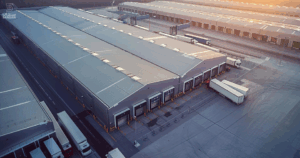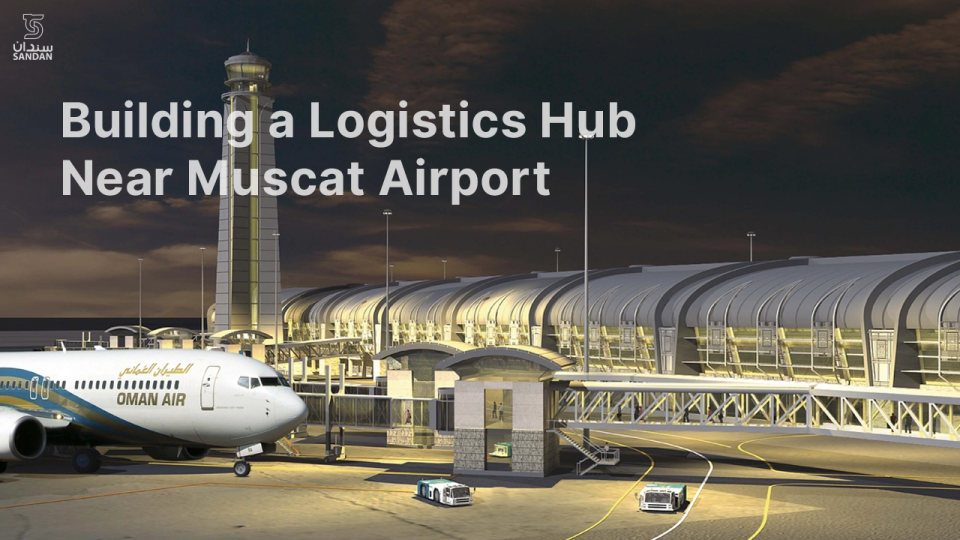Oman’s strategic location at the crossroads of Asia, Africa, and the Middle East makes it a rising hub for global trade and logistics. With Muscat Airport rapidly growing into a key node in the region’s cargo and freight ecosystem, the demand for logistics land near Muscat Airport is soaring. Whether you’re a logistics company, warehouse operator, or an investor seeking industrial opportunities, now is the right time to capitalize on Oman’s expanding logistics infrastructure.
The area surrounding Muscat Airport is rapidly becoming a hub for logistics, offering excellent connectivity to seaports, highways, and regional trade zones. Backed by Vision 2040 and supportive government policies, Oman encourages private investment in industrial development, particularly in locations close to key transport corridors.
This blog explores everything you need to know about building a logistics hub near Muscat Airport—from identifying the right logistics land near Muscat Airport, understanding permit requirements, setting up operations, and analyzing the long-term return on investment (ROI). Whether you are a local entrepreneur or a foreign investor, this guide will help you navigate the opportunities and processes with clarity and confidence.
Why Muscat Airport Is a Strategic Location?
When it comes to establishing a logistics hub, location is everything. Muscat Airport stands out as a high-potential epicenter due to its exceptional geographical positioning, growing infrastructure, and increasing freight capacity. Choosing logistics land near Muscat airport puts your business at the crossroads of regional and international trade, making it ideal for companies aiming to scale operations across the GCC, East Africa, and South Asia.
#1 Gateway to GCC, Indian Ocean, and Africa
Muscat’s proximity to the Arabian Sea gives it direct maritime access to the Indian Ocean and East Africa. It also offers logistical reach to key GCC countries such as the UAE, Saudi Arabia, and Qatar via major highways and border routes. By establishing your base on logistics land near Muscat airport, you gain a competitive edge in delivering goods quickly and cost-effectively to some of the most commercially active regions in the world.
#2 Rapidly Growing Air Cargo Traffic
Muscat Airport is one of Oman’s fastest-developing air freight hubs, handling thousands of tons of cargo annually. With dedicated cargo terminals, cold storage facilities, and direct international flight routes, it is poised to become a logistics powerhouse. This growth aligns with Oman’s Vision 2040, which places a heavy emphasis on transforming the Sultanate into a globally connected logistics hub. Investing in logistics land near Muscat airport allows businesses to seamlessly integrate air freight into their supply chain and minimize turnaround times.
#3 Seamless Connectivity to Ports and Industrial Zones
Beyond air cargo, Muscat is well-connected to critical maritime ports such as Sohar Port and Duqm Port, both key to Oman’s logistics network. In addition, industrial zones like Rusayl Industrial Estate and Sandan Industrial Park offer excellent synergy for businesses needing warehousing, assembly, and distribution capabilities. These multimodal connections reduce transit time, lower transportation costs, and enhance supply chain reliability, making logistics land near Muscat airport a lucrative long-term investment.
#4 Sandan’s Advantageous Positioning
One standout location is Sandan Industrial Park, located conveniently within the greater Muscat region. It offers ready-to-build commercial and industrial plots, affordable long-term leasing options, and a supportive business ecosystem. Sandan’s proximity to Muscat Airport means investors can tap into a complete logistics and industrial solution in a single, integrated environment. Whether you’re transporting auto parts, electronics, or consumer goods, being near the airport ensures faster movement and operational efficiency.
Understanding the Demand: Oman’s Logistics Growth
Oman’s logistics sector is undergoing a rapid transformation, positioning itself as a critical player in the global supply chain. With its geographic advantage, business-friendly policies, and strong government backing, the Sultanate is attracting local and international businesses that are actively seeking logistics land near Muscat airport to build or expand their operations.
Steady Growth in the Logistics Sector
According to the Oman Logistics Center (OLC), Oman’s logistics industry is projected to contribute over 14% to the country’s GDP by 2040. The sector has seen double-digit growth over the past few years, fueled by increasing trade flows, rising demand for warehousing, and enhanced transport infrastructure. This expansion is not just limited to seaports or highways—the demand for well-located, air-linked logistics hubs has never been higher, making logistics land near Muscat airport a valuable asset for forward-thinking investors.
E-commerce, Retail, and FMCG Fueling Demand
With a young, tech-savvy population and high internet penetration, Oman is witnessing a significant rise in e-commerce activity. Global platforms, regional delivery networks, and local retailers are all scaling up their last-mile logistics capabilities. In parallel, the fast-moving consumer goods (FMCG) sector—including food, personal care, and household items—continues to expand. These trends are driving the need for warehouse clusters and distribution centers near the capital, particularly in areas offering quick access to flight-based cargo solutions. As a result, logistics land near Muscat airport has become a hotspot for companies looking to keep up with evolving customer expectations.
Muscat’s Role as a Central Logistics Node
Muscat is more than just the administrative capital; it is the heart of Oman’s logistics and distribution activity. Its central location ensures seamless connections to other major cities such as Sohar, Nizwa, and Sur. The ability to move goods efficiently from the airport to inland or coastal destinations makes Muscat a natural choice for logistics investments. Businesses that secure logistics land near Muscat airport can integrate both air and land transportation into their supply chain, improving responsiveness and reducing delivery costs.
Government Support for Private Sector Logistics Development
The Omani government, under Vision 2040, has introduced a number of initiatives to attract private investment in logistics. These include reduced red tape for permits, subsidized industrial land, customs reforms, and support for digital supply chain technologies. Such policies make the development of logistics land near Muscat airport not only accessible but also strategically wise for long-term growth.
Types of Logistics Land Near Muscat Airport
The area surrounding Muscat International Airport offers a diverse range of land options tailored to the varying needs of logistics businesses. Whether you’re a warehousing operator, a freight handler, or an investor aiming to develop logistics infrastructure, choosing the right logistics land near Muscat airport is critical for long-term operational efficiency and regulatory compliance.
Type 1. Warehouse-Ready Plots
For businesses looking to hit the ground running, warehouse-ready plots are an excellent choice. These are pre-zoned lands equipped with essential infrastructure like paved roads, drainage, and utility access. Often located within designated logistics corridors or industrial estates, these plots offer convenience for companies that want to build quickly with minimal bureaucratic hurdles. Investing in such logistics land near Muscat airport reduces lead time to market and ensures smooth setup of storage and distribution facilities.
Type 2. Built-to-Suit Logistics Properties
Built-to-suit options offer the flexibility to develop custom logistics hubs based on your operational needs. These can include cold storage facilities, distribution centers, cross-docking terminals, or multi-level warehouses. Developers often collaborate with clients to construct facilities aligned with international logistics standards. This approach is ideal for enterprises with specific space, technology, or design requirements. Selecting built-to-suit logistics land near Muscat airport ensures optimized layout and long-term scalability.
Type 3. Free Zone vs. Non-Free Zone Industrial Land
Muscat and its surrounding areas offer both free zone and non-free zone land for logistics development. Free zones such as Al Mazunah or Sohar Freezone provide benefits like 100% foreign ownership, tax exemptions, and relaxed customs regulations. However, not all free zones are close to the airport. On the other hand, non-free zone logistics land near Muscat airport—such as in Sandan Industrial Park—offers proximity benefits, government support, and growing local demand. Businesses must weigh the trade-offs between regulatory benefits and logistical convenience when selecting a location.
Type 4. Size and Zoning Categories
Logistics land near Muscat airport comes in a variety of sizes—from small parcels ideal for localized storage units to large tracts suitable for regional distribution centers. It’s crucial to understand zoning categories before investing. Common zoning includes:
- Light Industrial: Suitable for packaging, light assembly, and warehousing.
- Commercial Use: Best for retail distribution, office spaces, or service centers linked to logistics.
Choosing the right zoning ensures compliance with building codes and future business expansion plans.
Land Acquisition Process in Oman
Securing logistics land near Muscat airport requires a clear understanding of the legal, procedural, and financial aspects of land acquisition in Oman. The country’s transparent and structured approach to industrial land allotment—coupled with its openness to foreign investment—makes the process relatively straightforward when approached with the right preparation.
Legal Requirements for Locals and Foreign Investors
Oman allows both local and foreign investors to lease industrial land for logistics and commercial development. While Omani nationals can acquire land more freely, foreign investors typically obtain land through long-term lease agreements, especially in designated industrial zones like Sandan. For non-Omani entities, land acquisition is generally permitted under the umbrella of an Omani-registered company or a joint venture with a local partner. In free zones, 100% foreign ownership is permitted along with lease-based land usage rights.
For those targeting logistics land near Muscat airport, it’s essential to register with the Ministry of Commerce, Industry and Investment Promotion (MoCIIP) and obtain relevant industrial or commercial licenses before proceeding.
Industrial Land Allotment: How It Works
Industrial land in Oman is usually allocated through government entities or through privately managed industrial parks like Sandan. Interested investors must submit a land allotment application detailing:
- Business activity
- Estimated investment
- Land area requirement
- Infrastructure needs (power, water, roads)
Upon approval, an initial land allotment agreement is issued, often followed by a timeline-based development commitment. For logistics land near Muscat airport, being located in a zone with pre-approved land designations can expedite the process significantly.
Leasing vs. Ownership Models
Land ownership in Oman is limited for expatriates; thus, leasing is the most common model for industrial and logistics land. Lease terms typically range from 25 to 50 years with renewal options. Leases often come with development conditions (e.g., commencing construction within a specific timeframe). Some private parks may offer lease-to-own models under special circumstances.
If your goal is to operate long-term in Oman while retaining flexibility, leasing logistics land near Muscat airport provides both accessibility and scalability.
Costs Involved
Acquiring land comes with several associated costs, including:
- Application and processing fees
- Lease deposits (typically refundable)
- Annual lease rates based on land size and location
- Registration fees with MoCIIP or relevant authorities
- Utility connection charges
- Any applicable municipal or administrative taxes
Overall, land near key infrastructure like Muscat Airport may carry a premium but delivers higher operational value and ROI.
# Tips for Working with Local Authorities
To streamline the land acquisition process:
- Work with a registered local consultant or legal advisor.
- Ensure all documentation is translated and legally attested.
- Build rapport with park management (e.g., Sandan) for guidance on zoning, permits, and utilities.
- Stick to development timelines to avoid penalties or revocation.
Navigating the acquisition of logistics land near Muscat airport becomes easier with local insights, proper documentation, and clear communication. Planning ahead ensures a smoother journey toward building a high-performing logistics hub.
Permits and Regulatory Approvals
Securing the right permits and regulatory clearances is a critical step in setting up operations on logistics land near Muscat airport. Oman offers a relatively investor-friendly regulatory landscape, but understanding the sequence of approvals is essential to avoid delays and ensure full legal compliance.
#1 Business Licensing Procedures
The first step is to obtain a commercial or industrial license from the Ministry of Commerce, Industry and Investment Promotion (MoCIIP) or, in some cases, through Oman’s Investment Promotion Agencies (IPAs). The type of license depends on the business activity—whether it’s warehousing, cargo handling, freight forwarding, or supply chain services.
Foreign investors are required to establish a legal business entity in Oman, such as an LLC, before applying. Many industrial parks, including Sandan, offer assistance with company registration and fast-tracked licensing support for businesses investing in logistics land near Muscat airport.
#2 Environmental and Municipal Approvals
Depending on the scale of the logistics operation, you may need environmental clearance from the Ministry of Environment and Climate Affairs, particularly for facilities that involve fuel storage, heavy vehicle movement, or large-scale emissions. Municipal approvals from the local Wilayat (governorate office) are also necessary for site development, sanitation compliance, and structural planning.
Environmental impact assessments (EIAs) may be required for large or specialized logistics hubs. Ensuring that the selected logistics land near Muscat airport is zoned for industrial or light commercial use can significantly reduce regulatory hurdles.
#3 Construction Permits for Logistics Infrastructure
Once land allotment is approved, you’ll need to apply for construction permits. These are issued by the municipal authorities and may involve approvals from:
- Directorate General of Housing and Urban Planning
- Directorate of Civil Defense (for fire safety compliance)
- Road and transport authorities (for vehicle access and loading zones)
Detailed architectural and engineering plans must be submitted for approval before any construction begins. Choosing logistics land in pre-developed zones like Sandan can simplify this process, as some approvals are streamlined.
#4 Utilities and Infrastructure Approvals
After construction clearance, you must apply for utility connections:
- Electricity: Through the relevant electricity distribution company
- Water & Waste Management: Via the Public Authority for Water (Diam)
- Telecom & Internet: Through Omantel, Ooredoo, or other providers
Infrastructure approvals are generally granted faster in industrial parks that already have grid access and utility lines laid out—another reason why logistics land near Muscat airport in integrated hubs is preferred.
#5 Timeline and Challenges to Anticipate
The full approval timeline can range from 2 to 6 months, depending on the size of the project, type of land, and whether it’s in a regulated industrial zone. Challenges may include:
- Language barriers or document translation delays
- Additional clearance for foreign ownership structures
- Coordination between multiple authorities
To overcome these, it’s recommended to work with a local business consultant or choose a managed industrial park that provides regulatory support. By carefully navigating permits and approvals, businesses can unlock the full value of logistics land near Muscat airport, laying a solid foundation for scalable and compliant operations.
Setting Up a Logistics Hub: Infrastructure Essentials
Once you’ve secured the right logistics land near Muscat airport and obtained the necessary permits, the next step is building a fully functional logistics hub that meets current operational demands and is ready to scale with future growth. A successful logistics setup hinges on more than just land—it requires robust infrastructure that ensures speed, efficiency, safety, and adaptability.
Road Access, Loading Bays & Warehouse Design
Strategic road connectivity is crucial for any logistics hub. The logistics land near Muscat airport offers excellent access to major highways, allowing for fast movement of goods across Oman and into neighboring GCC countries. When selecting land, ensure it has direct access roads and space for wide-turning vehicles like trailers and trucks.
Loading bays—both dock-high and ground-level—must be integrated into the warehouse design to enable efficient inbound and outbound logistics. Standard warehousing in Oman often includes:
- Clear heights of 8–12 meters for vertical storage
- Reinforced flooring for heavy pallet loads
- Ventilation systems for climate-sensitive goods
A well-designed warehouse optimizes space utilization, improves staff safety, and reduces loading/unloading time.
Cold Chain, Dry Storage & Vehicle Fleets
Depending on your sector—FMCG, pharmaceuticals, e-commerce, or agriculture—you may need specialized storage solutions. Cold chain infrastructure (refrigerated units and climate-controlled areas) is vital for perishable items, while dry storage is used for electronics, textiles, and consumer goods.
Establishing your logistics base on logistics land near Muscat airport allows proximity to air cargo terminals, ensuring fast transition of temperature-sensitive products.
In addition, vehicle fleets are central to your hub’s operations. Consider:
- On-site parking and maintenance zones
- Fueling points or EV charging stations
- GPS tracking and fleet management systems
Having space to manage your own fleet improves operational control and delivery consistency.
Technology & Automation Infrastructure
Modern logistics hubs rely heavily on digital tools. Your facility should be built with:
- Warehouse Management Systems (WMS)
- Barcode and RFID tracking
- Automated sorting and conveyor systems
- CCTV and access control systems
When choosing logistics land near Muscat airport, ensure that telecom and IT infrastructure can support cloud-based platforms and 24/7 surveillance. Technology reduces manual errors, speeds up inventory movement, and allows real-time performance monitoring.
Scalability for Future Expansion
A key advantage of developing on logistics land near Muscat airport is the opportunity for future scalability. As your business grows, you may need to add storage wings, office spaces, or automated zones. Select a plot that gives you:
- Extra buffer land
- Flexible zoning permissions
- Expansion-ready utilities and infrastructure
Costs and ROI: Is It Worth the Investment?
Establishing a logistics hub requires significant upfront capital, but when located strategically, such as on logistics land near Muscat airport, the returns can be both strong and sustainable. By understanding the full cost breakdown and the potential for rental yield or operational savings, investors and business owners can make informed, data-driven decisions.
Initial Setup Costs
Investing in logistics land near Muscat airport typically involves the following one-time expenditures:
#1 Land Lease or Purchase
Depending on size, location, and zoning, lease rates can vary but are generally competitive compared to other GCC countries. Industrial parks like Sandan often offer subsidized rates or long-term lease benefits.
#2 Construction Costs
Warehouse construction in Oman may cost anywhere from OMR 90–150 per square meter, depending on design complexity and materials.
#3 Permits & Licensing
Fees related to business licensing, municipal permits, and environmental clearances can add 5–10% to initial investments.
#4 Staffing & Equipment
Costs for skilled labor, machinery, forklifts, racking systems, and IT setups should also be accounted for during planning.
A medium-sized logistics facility on logistics land near Muscat airport might require an initial investment ranging from OMR 500,000 to 1 million, depending on scale and automation level.
Operational Costs
Once operational, monthly running costs include:
#1 Utilities
Water, electricity, and cooling (especially for cold storage) can be significant, though many parks offer optimized infrastructure to reduce energy waste.
#2 Maintenance & Security
Includes CCTV systems, 24/7 personnel, and equipment upkeep.
#3 Staff Salaries
Logistics coordinators, warehouse workers, drivers, and facility managers.
Proximity to Muscat Airport helps reduce transportation costs and downtime, translating to operational savings over time.
Rental Yields in Muscat’s Logistics Market
For investors looking to lease out logistics properties, average rental yields in Muscat range between 6% to 9% annually, depending on the facility’s features and location. Properties on logistics land near Muscat airport command higher rents due to demand from fast-moving sectors like FMCG, e-commerce, and pharmaceuticals.
Modern facilities with cold storage, large loading areas, and strong road access can achieve even higher returns.
ROI Timeline: 3-Year and 5-Year Scenarios
3-Year Horizon
Break-even is possible with consistent leasing and low vacancy rates. Companies operating their own facilities often recover 60–70% of initial costs via operational savings and throughput gains.
5-Year Horizon
Strong ROI is likely through lease revenue, expanded operations, or even asset appreciation. Owning or leasing logistics land near Muscat airport positions your business for long-term efficiency and profit.
Hypothetical ROI Projection
Let’s say a company invests OMR 800,000 into a 2,000 sqm logistics facility on land leased near the airport. At a rental rate of OMR 3 per sqm/month:
- Annual revenue: OMR 72,000
- Yield: ~9%
- Break-even: Year 5 (with rising demand and occupancy)
With government support and increasing market demand, logistics land near Muscat airport proves to be a high-potential asset for both end-users and investors.
Sandan Industrial Park: A Strategic Opportunity
For businesses and investors seeking high-potential logistics land near Muscat airport, Sandan Industrial Park stands out as one of Oman’s most strategically located and well-equipped developments. Located just minutes away from Muscat International Airport, Sandan offers direct access to air freight facilities, major road networks, and nearby seaports, making it an ideal logistics and industrial gateway.
Proximity That Powers Performance
Sandan’s location near Muscat Airport enables rapid movement of goods and materials across Oman and the wider GCC. For logistics companies handling time-sensitive cargo, perishable goods, or regional distribution, setting up operations within Sandan significantly reduces transit delays and operational bottlenecks. By acquiring logistics land near Muscat airport inside Sandan, businesses position themselves at the heart of Oman’s multi-modal trade corridor.

Integrated Ecosystem with End-to-End Services
What sets Sandan apart from other industrial zones is its integrated ecosystem designed to support business operations and employee convenience. Within the park, you’ll find:
- Banking & Financial Services for easy transactions and investor needs
- Vehicle Services, including tire shops, auto repair, and car care centers
- Retail Outlets & Electronics Shops to support operational procurement
- Restaurants & Cafés catering to employees and visitors
This mix of services not only enhances operational efficiency but also boosts employee satisfaction, critical for long-term business sustainability.
Affordable Commercial Spaces & Flexible Leasing
Sandan Industrial Park offers logistics land near Muscat airport at competitive leasing rates. Whether you’re a startup logistics provider or a multinational enterprise, Sandan’s flexible leasing options accommodate a range of business sizes. Additionally, the park management assists with:
- Fast-tracked business registration
- Permit facilitation with government authorities
- Custom-built property development
The affordability and support structure make it easier for businesses to launch and scale without excessive upfront risk.
A Smart Choice for Local and Foreign Investors
For local entrepreneurs, Sandan provides a ready-made platform to tap into Oman’s booming logistics economy. For foreign investors, it offers the advantage of proximity, infrastructure, and regulatory support—all under one roof. Combined with Oman’s investor-friendly policies and Vision 2040’s focus on logistics, investing in logistics land near Muscat airport within Sandan is a forward-thinking move toward sustainable growth.
Tips for Investors and Entrepreneurs
Investing in logistics land near Muscat airport offers immense potential—but like any strategic move, success depends on informed decisions and careful planning. Whether you’re a local entrepreneur or an international investor, the following tips can help you navigate the logistics landscape in Oman more confidently:
Tip 1. Do Your Market Research
Before investing, study Oman’s logistics trends, competitor activity, and sector-specific demand (e.g., FMCG, pharma, e-commerce). Understand which locations and logistics services are growing and how your offering can meet local or regional gaps.
Tip 2. Work with a Local Consultant or Agent
Navigating permits, regulations, and negotiations is much smoother with the support of a local business consultant. They can help you evaluate the best logistics land near Muscat airport, handle documentation, and liaise with regulatory bodies efficiently.
Tip 3. Understand Zoning and Leasing Terms
Be clear about the land’s permitted usage—whether it’s zoned for light industrial, warehousing, or commercial operations. Read leasing contracts carefully to understand duration, development requirements, and renewal clauses.
Tip 4. Prioritize Scalability and Infrastructure
Choose land that allows for future expansion and has access to essential infrastructure—utilities, roads, telecom, and workforce. Scalability ensures your logistics operations can grow with market demand.
FAQs
What makes the logistics land near Muscat airport a good investment?
Logistics land near Muscat airport offers strategic proximity to Oman’s main air cargo hub, strong connectivity to highways and seaports, and access to growing markets across the GCC and East Africa. It supports faster delivery times, reduced transport costs, and high rental yield potential.
Can foreign investors acquire logistics land near Muscat airport?
Yes, foreign investors can lease logistics land near Muscat airport through long-term contracts, especially in designated industrial zones like Sandan. Free zones also offer 100% foreign ownership with additional incentives.
What is the average cost of setting up a logistics hub near Muscat airport?
Initial setup costs vary based on land size, design, and infrastructure. A medium-sized logistics facility may require an investment between OMR 500,000 to 1 million, including land lease, permits, construction, and equipment.
How long does it take to get permits for developing logistics land near Muscat airport?
The permit process typically takes 2 to 6 months. This includes business registration, environmental clearances, construction approvals, and utility connections. Working within industrial parks like Sandan can speed up the process.
What types of logistics facilities can be built near Muscat airport?
Businesses can develop a wide range of facilities, including cold storage warehouses, dry goods storage, distribution centers, and cross-docking terminals. Built-to-suit options are also available on logistics land near Muscat airport to meet specific operational needs.

Conclusion
As Oman positions itself as a regional logistics powerhouse, investing in logistics land near Muscat airport offers a timely and strategic opportunity. With its proximity to major trade routes, seamless access to air, sea, and land transport, and growing demand for warehousing and distribution services, the area around Muscat Airport is emerging as a prime logistics hotspot.
From streamlined land acquisition processes and investor-friendly regulations to scalable infrastructure and strong rental yields, the benefits are clear for both local entrepreneurs and foreign investors. Sandan Industrial Park, in particular, stands out as a fully integrated business environment that combines location advantage with operational convenience.
Whether you’re looking to build a custom logistics hub or lease a facility to capitalize on rising demand, logistics land near Muscat airport offers the foundation for sustainable growth and high ROI. Now is the time to act—secure your position in Oman’s logistics future and build a business that’s ready for regional and global trade.












